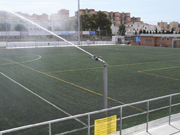
Conventional sports field irrigation systems are everywhere. They are typically comprised of sprinkler heads spaced at even intervals in the play area. These sprinkler heads in the play area can cause a few issues, notably safety to the players and sports field maintenance constraints.
Wouldn’t it be great if the majority of this equipment was placed out of play? Think how easy it would be to maintain the field if pipes and sprinkler heads were not in the area of play. There would be less concern over player injury…remove some of the variables and these millionaire players will be safer when they play. Fewer player injuries would be most beneficial to all parties.
Terry Ormrod of The Toro Company, Canada, speaks to this saying in a recent release that “Sports field irrigation applications can tax the capability of any rotor. One either has to rely on sprinklers installed on the perimeters (which may struggle to throw water far enough to achieve true head-to-head coverage), or installing sprinklers on the actual playing surface, which may result in unevenness in the playing surface and pose an injury risk to athletes. While there are sprinklers that have the distance to be installed solely on the perimeters, they are often very large and expensive. Also, although most sprinklers designed for in-field installation come equipped with protective rubber covers, they still represent breaks in the playing surface, and provide only partial protection against injury.”
Europe has been watering sports fields from the sidelines utilizing big guns for awhile now. It takes high water pressure and lots of water (gpm) to enable a stream of water to cross a sports field. One hundred psi and 60 gpm are not uncommon numbers when designing these systems. Safety is paramount, but cooling is also a consideration.
A.J. Powell, Jr., extension turfgrass specialist, states that “the surface of a dry turf may reach temperatures well above 120 degrees Fahrenheit during hot, late-summer days. The same, well-irrigated turf may only reach a temperature of 90 to 95 degrees. This certainly reduces stress upon players relative to heat exhaustion, fatigue, etc.”
Powell continues, noting that “many new fields are now being watered with large water guns, placed off the playing surface. These are manual systems that require physically changing the gun location after each portion of the field is irrigated. These guns require fairly large piping and excellent pressure to operate properly. The advantage of the water gun over an automatic pop-up system is that there is no piping required within the field and you have no underground pop-up sprinklers that have to be avoided when you aerate a field.”
Kreisregner LVKR Large Throw Sprinkler…Underhill International
However, some countries in Europe have been using large water guns that are installed off field, housed in inground compartments that allow the big gun sprinklers to automatically pop up. This is similar to conventional sports irrigation sprinkler heads. The difference is no equipment, piping, plastic sprinkler fittings and parts are not located within the sports field soil.
Large, higher pressure and much higher water consumption sprinklers are now available for completely off-perimeter watering of sports fields. Toro has developed one that pops up, does it watering and then pop down into an in ground housing. The TG101 large-radius gun style sprinkler is capable of distributing water across the width of the sports field, while located in the perimeter area. No equipment at all is placed in the field play area.
Of course larger pipe sizes are required to carry the gallons per minute (gpm) and higher water pressures (psi) are required to provide the force to throw the water a long distance while operating at optimum conditions. To achieve a 60-yard (180-foot) wetted area, a water supply of 248 gpm at 95 psi (at the sprinkler) is needed. This requires a four-inch PVC Class 200 pipe supply and, in most cases, a centrifugal pump to boost the water pressure.
Now, if you are planning a new sports field with turf or artificial turf and require irrigation, you have a choice. Even though this new watering method utilizing large radius sprinklers (LRS) may look strange when compared to conventional sports filed irrigation systems, it has its benefits. Safety for the players is huge as an injury to a professional athlete could be very costly. Maintenance issues are now nonexistent as far as irrigation of in play equipment is concerned. The costs are competitive while the benefits are many and in this day and age of liability issues, due diligence by management dictates that if there is a safer way to achieve a goal then this certainly requires consideration. Change is upon us to approach sports irrigation with an open mind.
Lorne Haveruk, principal, DH Water Management, educator and author is one of the country’s leading water resource consultants. DH Water is focused on all aspects of water resource management. For educational offerings and other services, visit www.dhwatermgmt.com. To contact the author directly, email lorne@dhwatermgmt.com .
Print this page